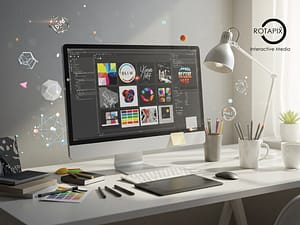AR ecommerce (Augmented Reality Ecommerce) refers to the integration of augmented reality technology within online shopping platforms. By using AR, customers can interact with products in a more immersive and engaging way, allowing them to visualise how products would look or function in real life before making a purchase. This technology is reshaping the ecommerce landscape by providing a more personalised, interactive shopping experience.
In a typical ar ecommerce setting, users can view 3D models of products, place them in real-world environments (such as viewing furniture in their own homes), or even try on items virtually, like clothes or accessories. This leads to better-informed purchasing decisions and higher customer satisfaction, as it significantly reduces uncertainty.
How AR Enhances Customer Interaction
AR technology in ecommerce opens up new possibilities for customer interaction. Instead of passively browsing through static images or product descriptions, AR allows customers to engage with products more meaningfully. For example, they can rotate, zoom in, or even place virtual products in their own environment using their smartphone or AR-enabled device. This level of interactivity helps customers better understand product features, dimensions, and aesthetics, which leads to more confident purchasing decisions.
With ar ecommerce, the shopping experience becomes much more dynamic, providing an immersive experience that traditional online shopping can’t offer. As this technology evolves, more customers are drawn to platforms that offer these features, as they get a clearer and more accurate understanding of the products they’re interested in.
Personalisation and Customisation in AR Ecommerce

Customising Products with AR
One of the greatest strengths of ar ecommerce is the ability to personalise and customise products in real-time. Whether customers are selecting the colour of a new sofa or customising the design of their dream sneakers, AR allows them to visualise these changes instantly. This enhanced level of personalisation is particularly appealing because it gives customers a sense of control over the final product. They can experiment with different variations and see how different customisations will look before committing to a purchase.
For businesses, offering these customisation options through ar ecommerce means fewer returns and more satisfied customers. By providing customers with a virtual representation of the exact product they’ll receive, they can be more confident in their choices. Whether it’s selecting different textures, sizes, or colours, the AR experience allows users to tailor their shopping experience to their exact preferences.
Augmented Reality Website Features
An augmented reality website is a platform that integrates AR technology into the ecommerce experience, enabling customers to interact with products directly through their browsers or mobile apps. These websites provide the perfect blend of functionality and innovation, allowing users to visualise products in a 3D environment or even in their physical space.
For example, customers shopping on an augmented reality website for home decor can use their phone’s camera to place virtual furniture in their living rooms to see how it fits and complements their existing decor. This not only improves the shopping experience but also gives customers greater confidence that the product they’re purchasing will meet their needs. The key to a successful augmented reality website lies in its user-friendly design, which ensures customers can easily navigate the AR features without technical difficulties.
Improved Confidence with Virtual Try-Ons and Previews
Reducing Uncertainty with Virtual Try-Ons
One of the most significant benefits of ar ecommerce is the ability to offer virtual try-ons, especially in industries like fashion, beauty, and eyewear. Customers can use their smartphones or tablets to see how clothes, accessories, or makeup products would look on them without physically trying them on. This technology helps reduce the uncertainty often associated with online shopping, where customers can’t physically interact with products before buying them.
For instance, in the beauty industry, AR allows users to virtually apply makeup, testing different shades and styles in real-time. In the fashion sector, virtual fitting rooms enable customers to try on outfits, ensuring they get the right size, fit, and style. This capability not only enhances the customer experience but also reduces return rates, as customers are more likely to make informed decisions.
Big Commerce Developer Solutions for AR Integration
To fully leverage the power of ar ecommerce, businesses often need to work with a Big Commerce Developer who specialises in integrating AR functionality into ecommerce platforms. Big Commerce Developers can create seamless AR experiences within an ecommerce store, ensuring that AR features, such as virtual try-ons or 3D product previews, are smooth and user-friendly.
Working with a Big Commerce Developer ensures that AR functionality is customised to fit the needs of the business, aligning with the overall ecommerce strategy. This integration can significantly improve the user experience by making the platform intuitive and engaging. Moreover, with AR technology in place, ecommerce platforms can stand out in the competitive online marketplace, offering a more immersive and satisfying shopping experience.
Enhanced Product Visualisation and Interaction
3D Product Visualisation
One of the standout features of ar ecommerce is the ability to offer 3D product visualisation. This technology allows customers to interact with products in ways that were previously only possible in physical stores. By using AR, customers can view products from multiple angles, zoom in to inspect details, and even place the product in their own environment to see how it fits or looks. This is particularly useful for products like furniture, home decor, or fashion accessories, where size, texture, and aesthetic details matter.
For example, in ar ecommerce, a customer shopping for a new sofa can use their smartphone to see a 3D model of the sofa placed in their living room. They can rotate the model, zoom in to view the fabric texture, and ensure that the size fits with the existing layout. This level of interaction gives customers a clearer understanding of the product, leading to more confident and informed purchasing decisions.
Interactive Product Demos
Another exciting aspect of ar ecommerce is the ability to offer interactive product demos. AR allows customers to test out products digitally before making a purchase, which is particularly beneficial for tech gadgets, appliances, or home goods. These AR demos simulate the experience of using the product, showing how it functions and fits into the customer’s daily life.
For instance, an AR demo for a new kitchen appliance might allow the customer to see how the appliance operates, its size compared to other kitchen items, and where it could be placed in their kitchen. This digital testing helps customers understand product features in a practical, hands-on way without needing to physically interact with the product, making the online shopping experience much richer and more engaging.
Increased Engagement and Customer Satisfaction
Creating Engaging Shopping Experiences
AR ecommerce transforms online shopping into a more engaging, interactive experience. Rather than simply browsing through static product images, customers are actively involved in the shopping process through AR features like virtual try-ons, 3D product visualisation, and interactive demos. This heightened level of interaction keeps customers engaged for longer periods, which often leads to increased satisfaction and higher conversion rates.
By making the shopping experience more fun and immersive, AR encourages customers to explore products in greater depth, reducing the uncertainty that typically comes with online shopping. This creates a stronger connection between the customer and the product, which is likely to result in more positive shopping experiences and repeat business.
Australian SEO Companies and AR Ecommerce Optimisation
Optimising an augmented reality website for search engines is crucial to ensuring that AR features are visible and easily accessible to potential customers. Australian SEO companies can play a vital role in optimising AR ecommerce websites by improving the site’s search rankings and user engagement. SEO companies focus on enhancing website content, speed, mobile compatibility, and user experience—all critical factors in the success of an AR-enhanced platform.
By employing strategic SEO techniques, australian seo companies can help ecommerce businesses reach a broader audience, attract more organic traffic, and ensure that their AR features are well-positioned on search engines. This leads to increased visibility and engagement, as more users can discover and interact with the immersive AR features on the site.
The Future of AR Ecommerce for Customer Experience
Why AR is a Game-Changer for Ecommerce
AR ecommerce is revolutionising the way customers shop online by offering a more interactive, personalised, and engaging experience. From 3D product visualisation to virtual try-ons and interactive demos, AR technology gives customers a sense of control over their shopping journey, leading to greater product confidence. This immersive experience helps reduce uncertainty and increases customer satisfaction, making AR a powerful tool for ecommerce businesses.
The Role of AR in Shaping Future Online Shopping Habits
As ar ecommerce continues to evolve, it will play an even more significant role in shaping future online shopping habits. The integration of AR into ecommerce platforms is expected to expand, with more businesses adopting AR features to provide unique, engaging shopping experiences. In the future, customers will come to expect these interactive features as standard, and ecommerce businesses that embrace AR will be better positioned to thrive in a competitive market. With the ongoing development of AR technology, the future of online shopping will become even more dynamic, immersive, and customer-centric.










